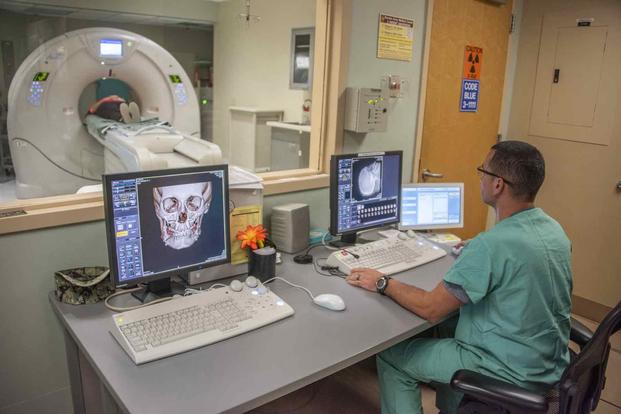The Defense Department's plan to cut 12,801 medical positions from the DoD, Army, Navy and Air Force was built on inadequate assessments, a shortcoming that could affect patient care, including treatment for service members during wartime, a new Government Accountability Office report finds.
The watchdog agency report released Tuesday said the department still has not "fully or consistently assessed the effects of potential reductions." In 2019, the Pentagon proposed to eliminate more than 17,000 uniformed medical billets – including 10,739 doctors, dentists, nurses, corpsmen and medics -- but the figure was later reduced by roughly 4,500 positions due to further analysis and attrition.
The idea was that some billets would be repurposed as operational billets -- combat or combat support jobs -- while leaner medical staffs provided care for all military personnel and dependents in some locations. Other family members and retirees were to be shifted to civilian care through the Tricare network.
According to the GAO, the department used wartime scenarios to determine how many active-duty medical personnel it would need but didn't actually define the requirements before proposing the cuts. The DoD also failed to factor in challenges with recruitment or retention when determining the size of its medical corps.
Regarding non-uniformed patients, including family members and retirees, the department developed a method for measuring the capability of the Tricare networks to absorb patients -- but then didn't use its own methodology to assess those networks.
Instead, it used population assessments done in 2018 that only looked at the population of communities, the Tricare-eligible population and the number of military treatment facility (MTF) enrollees, along with any notes of known network limitations, rather than a deep-dive analysis of providers and available care.
The GAO noted that the DoD's top strategy for providing care for family members and retirees is to hire civilian providers or contract them, but it faces challenges given nationwide shortages of trained medical personnel and competition with the private sector and Department of Veterans Affairs.
"According to DoD's ... plan, hiring civilian employees would help mitigate the loss of active-duty medical personnel. However, according to DoD officials, this is not always an available option, as previously noted," GAO analysts wrote in their report, which is titled Additional Assessments Needed to Determine Effects of Active-Duty Medical Personnel Reductions.
With military treatment facilities unable to hire replacements or accommodate appointments, the staff cuts could send even more patients, including active-duty troops, to civilian providers.
"This could lead to a number of undesirable outcomes," the analysts wrote.
The watchdog warned that the DoD runs the risk of faltering patient care and may be unable to care for the combat wounded during wartime. The GAO noted, for example, that the services run the risk of not having enough people to care for casualties returning from a large-scale conflict.
"Until DoD develops and uses guidance to comprehensively assess the potential effect that reductions may have on MTFs, it risks taking actions that could decrease the ability of the military health system to achieve its mission of ensuring the medical readiness of the force and caring for military service members and their families," according to the report.
The planned staffing reductions are part of military medical reforms that began in 2013 with the creation of the Defense Health Agency and escalated in 2017 when Congress gave the Defense Health Agency authority to reevaluate the scope of all military treatment facilities and how the DoD serves non-uniformed beneficiaries, including family members and retirees.
The reform initiatives also called for realigning or closing roughly 50 hospitals and clinics, and handing responsibility for military operational medicine and care for uniformed personnel to the service medical commands.
The DoD placed the personnel cuts on hold during the COVID-19 pandemic, and Congress halted the billet cuts in the fiscal 2020 defense authorization act, ordering the Pentagon to conduct a review of each service's manpower requirements, a billet analysis, a plan to address gaps and assessments of Tricare networks in communities.
The military medical workforce was stretched thin during the pandemic as the services deployed members to sites nationwide to care for civilians in hard-hit areas and facilities. The DoD inspector general found that staff shortages related to the planned reduction, which were the result of the services failing to fill billets slated to be trimmed, contributed to burnout and led military treatment facilities to decrease the number of available beds for inpatient care and increased the number of referrals of active-duty personnel to civilian care.
Even as the pandemic has wound down, the problems appear to continue. Military personnel in the Pacific Northwest, for example, reported that they could not get required pre-deployment physicals as a result of shortages, and several Navy hospitals worldwide are experiencing critical shortages in certain departments, especially labor and delivery.
The GAO made nine recommendations to the DoD and to the services to improve their assessments of their military medical manpower needs, as well as measuring the adequacy of Tricare networks and continuous monitoring to ensure that they can care for the patient load.
In their response to the report, DoD officials concurred with all nine recommendations but made no comment on the GAO's assessment.
-- Patricia Kime can be reached at Patricia.Kime@Military.com. Follow her on Twitter and Threads @patriciakime
Related: Plans for Hospital Closures as Part of Military Health System Reform Forging Ahead After Pause














